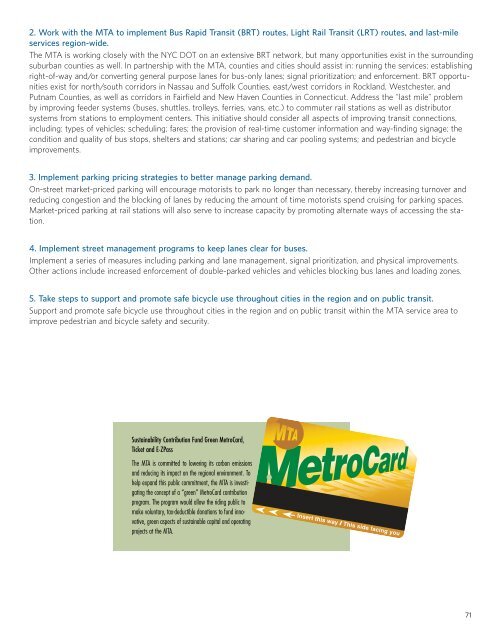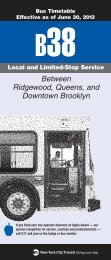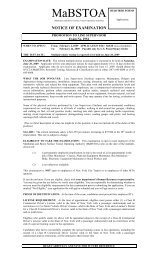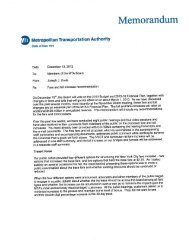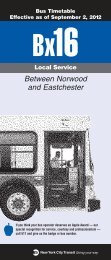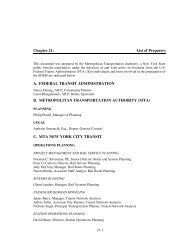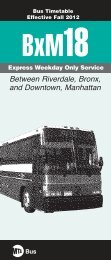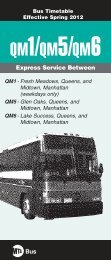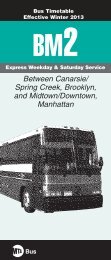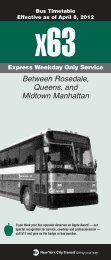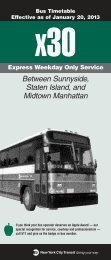Greening Mass Transit & Metro Regions: The Final Report - MTA
Greening Mass Transit & Metro Regions: The Final Report - MTA
Greening Mass Transit & Metro Regions: The Final Report - MTA
Create successful ePaper yourself
Turn your PDF publications into a flip-book with our unique Google optimized e-Paper software.
2. Work with the <strong>MTA</strong> to implement Bus Rapid <strong>Transit</strong> (BRT) routes, Light Rail <strong>Transit</strong> (LRT) routes, and last-mile<br />
services region-wide.<br />
<strong>The</strong> <strong>MTA</strong> is working closely with the NYC DOT on an extensive BRT network, but many opportunities exist in the surrounding<br />
suburban counties as well. In partnership with the <strong>MTA</strong>, counties and cities should assist in: running the services; establishing<br />
right-of-way and/or converting general purpose lanes for bus-only lanes; signal prioritization; and enforcement. BRT opportunities<br />
exist for north/south corridors in Nassau and Suffolk Counties, east/west corridors in Rockland, Westchester, and<br />
Putnam Counties, as well as corridors in Fairfield and New Haven Counties in Connecticut. Address the “last mile” problem<br />
by improving feeder systems (buses, shuttles, trolleys, ferries, vans, etc.) to commuter rail stations as well as distributor<br />
systems from stations to employment centers. This initiative should consider all aspects of improving transit connections,<br />
including: types of vehicles; scheduling; fares; the provision of real-time customer information and way-finding signage; the<br />
condition and quality of bus stops, shelters and stations; car sharing and car pooling systems; and pedestrian and bicycle<br />
improvements.<br />
3. Implement parking pricing strategies to better manage parking demand.<br />
On-street market-priced parking will encourage motorists to park no longer than necessary, thereby increasing turnover and<br />
reducing congestion and the blocking of lanes by reducing the amount of time motorists spend cruising for parking spaces.<br />
Market-priced parking at rail stations will also serve to increase capacity by promoting alternate ways of accessing the station.<br />
4. Implement street management programs to keep lanes clear for buses.<br />
Implement a series of measures including parking and lane management, signal prioritization, and physical improvements.<br />
Other actions include increased enforcement of double-parked vehicles and vehicles blocking bus lanes and loading zones.<br />
5. Take steps to support and promote safe bicycle use throughout cities in the region and on public transit.<br />
Support and promote safe bicycle use throughout cities in the region and on public transit within the <strong>MTA</strong> service area to<br />
improve pedestrian and bicycle safety and security.<br />
Sustainability Contribution Fund Green <strong>Metro</strong>Card,<br />
Ticket and E-ZPass<br />
<strong>The</strong> <strong>MTA</strong> is committed to lowering its carbon emissions<br />
and reducing its impact on the regional environment. To<br />
help expand this public commitment, the <strong>MTA</strong> is investigating<br />
the concept of a “green” <strong>Metro</strong>Card contribution<br />
program. <strong>The</strong> program would allow the riding public to<br />
make voluntary, tax-deductible donations to fund innovative,<br />
green aspects of sustainable capital and operating<br />
projects at the <strong>MTA</strong>.<br />
71


